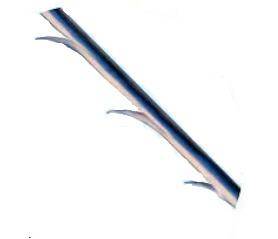Looking for a thread lift in NY?
This past week, Gwyneth Paltrow’s site, Goop published an article about threading and how it is positioned to replace surgical face lifts. A french dermatologist and a plastic surgeon from Singapore were interviewed about the thread lift procedure and they touted it as the next big thing. Are they right?
What happened to thread lifts?
The thread lift (Contour Lift and Aptos Lift) was introduced in the U.S. after receiving approval from the FDA in 2004. FDA clearance was withdrawn in 2007 after numerous complaints from patients. What were the issues? The sutures that were made of a permanent material (polypropylene) could poke through the skin, cause dimples and irregularities, and sometimes cause infections.
The popularity of the procedure rocketed because many baby-boomers were interested in the promise of a younger face without surgery. The same reasons are why Botox is the number 1 cosmetic procedure in the world.
I never performed these early thread lifts but I know some skilled surgeons that did use them in this window of time and I’ve removed the threads from several patients. The most common complaint I’ve heard from both doctors and patients about the contour thread lift is that the results didn’t last very long. They would hold their effects for only 3 -6 months in most cases. In comparison, filler treatments can last a year or more, and a surgical facelift can last 7 – 10 years. Although most people who seek a thread lift are not in the market for surgery, they usually want a non-surgical fix.
One doctor in the Goop article discusses a sugar-based thread that is not available in the U.S. but it dissolves several weeks after being placed under the skin. It’s unlikely that this will last longer than a permanent (or semi-permanent) stitch like the Contour threads but the concept sounds to be safer than the old thread lifts in some ways.
Other threads made of dissolvable material have become very popular in Korea and Europe and have made their way to the U.S.. These new threads (PDO and PLA) are absorbed by your body over 4-6 months and have shown more promise as an injectable procedure in the same class as fillers and Botox since they need to be repeated at intervals to maintain the results.
A closeup of the permanent Contour thread, with fine barbs,
previously used for non-surgical facelifts
Why don’t thread lifts last?
The idea of the thread lift is very clever. A stitch with small notches (to grab a hold of the tissue under your skin) is passed along your neck, cheek, jawline, or brow and pulled in a direction that raises and tightens the area of concern. The procedure aims to create a face lift without major surgery or incisions.
Here’s why the early thread lifts didn’t work that well:
- To achieve a durable lift of part of the face, the droopy area needs to be separated and re-positioned which usually requires a surgery. The thread lift cinches, but doesn’t re-position. You’re usually back where you started after several months.
- Signs of facial aging are related to fat and volume loss as much as they are about drooping and gravity. Right now, the best non-surgical face lifts are combination procedures using a carefully selected and administered series of fillers, laser, and sometimes Botox or Dysport. Threads can be combined with these mainstay procedures but they are not necessarily a perfect stand-alone solution.
Why do some doctors still advertise thread lifts in the U.S.?
The same company that manufactured the threads for cosmetic purposes have found a more accepted application for their product- wound closure. The barbed stitches work very well to maintain the tension on a long cut or surgical incision while it is healing. I’ve used the rebranded product (called the Quill Suture) for several years now and it is an efficient and reliable “knotless” way to close an incision. Some doctors are using these wound-closure stitches to perform the same thread lifts of 2005, albeit with slight variations.
The general consensus among cosmetic surgeons is that the original polypropylene hread lifts are out for now.
[Added April,2016] A new version of thread lifts has made it to the United States and these are called the PDO thread lifts, Nova Threads, Silhouette Lift, or embedding therapy. This procedure uses a dissolving thread that can be barbed or smooth and is injected under the skin without knotting or tying. The thread dissolves over 4-6 months and stimulates a mild inflammatory reaction that can result in some modest tightening and collagen build-up. 6-30 threads are placed at one time. Safer than the old thread lifts? Yes. Effective? It’s likely better than some of the existing radiofrequency skin tightening procedures like Thermage, Pelleve, and Thermi.



